Outforia Quicktake: Key Takeaways
- Tiger sharks and great white sharks are large-bodied shark species with different appearances, diets, and geographic ranges.
- While tiger sharks are known for their stripes and diverse diet, great whites have a conical snout and prefer seals and sea lions.
- Both sharks are part of the “Big Three” for the highest number of attacks on humans, but statistics show that shark attacks are relatively rare.
- Great whites are vulnerable according to IUCN, while tiger sharks are considered near threatened.
- Despite similarities in distribution and size, tiger sharks and great whites have distinct habitats and migratory patterns.
Tiger sharks and great white sharks are two large-bodied shark species. As with other shark species, tiger sharks and great whites have a lot in common. But what’s the difference between the tiger shark vs great white shark?
Tiger sharks and great whites aren’t as closely related to each other as other species because they don’t belong in the same shark family. They also have different appearances, feeding habits, diets, and geographic distributions and ranges.
What is a Tiger Shark?
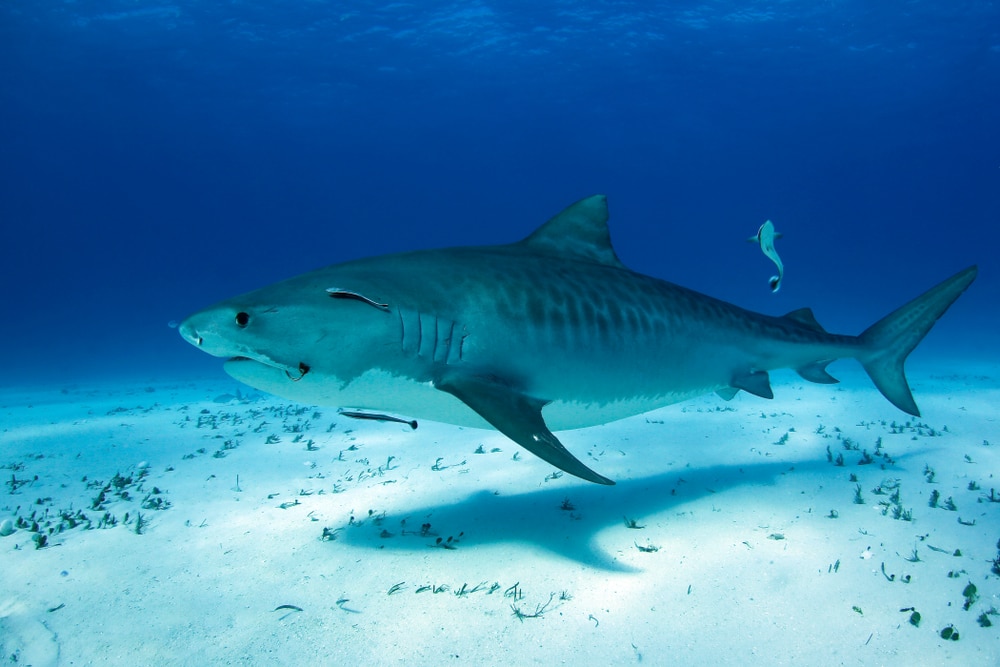
The tiger shark (Galeocerdo cuvier) is a large-bodied shark belonging to the order Carcharhiniformes. More than 270 types of sharks belong to the Carcharhiniformes, making it the largest order of sharks.
Within this order, tiger sharks are separated into the family Carcharhinidae, also known as requiem sharks. Some close relatives include bull sharks, spinner sharks, and blacktip sharks.
Tiger sharks are the only living species in the genus Galeocerdo. These sharks first appeared in the Paleocene Epoch about 56–66 million years ago.
Tiger sharks are easily distinguishable compared to other requiem sharks because of their stripes. It can be difficult to distinguish other requiem sharks from each other because they lack distinct characteristics. This often leads to misidentification when shark attacks occur.
What is a Great White Shark?

The great white shark (Carcharodon carcharias) is one of the largest shark species in the world. It belongs to the order Lamniformes, which includes mackerel sharks. The mackerel shark family Lamnidae includes large predatory fish.
Similar to the tiger shark, great whites are the only living species in their genus, Carcharodon.
The ancestors of great whites are believed to have appeared sometime in the early Miocene or late Oligocene epochs, around 23–40 million years ago.
Great whites are often easily recognizable due to their round, torpedo-shaped bodies and prominent white underbellies.
What’s the Difference Between a Tiger Shark vs Great White Shark

Tiger sharks and great white sharks are both part of the “Big Three”. This refers to the top three sharks with the most attacks recorded. The bull shark is the third member of the Big Three.
There are several differences between the tiger shark vs great white shark, which range from its preferred habitat to its diet and conservation status.
Size and Appearance

Tiger sharks are smaller than great whites. Tiger sharks average about 10–14 ft (3–4 m) in length.
Some individuals may reach a maximum of 18 feet (5.5 meters) in length. They average up to 1,400 pounds (635 kg), with some individuals exceeding 2,000 pounds (907 kg).
Great white sharks are one of the largest shark species, averaging about 16–20 ft (5–6 m) in length. They can weigh anywhere between 4,000 and 7,000 pounds (1,814 and 3,175 kg).

Tiger sharks and great whites have very different appearances. Tiger sharks are named for the stripes they have on their bodies. The stripes are more apparent in the juvenile stage. They slowly fade as they mature into adults.
Tiger sharks have a gray to dark gray dorsal surface with a pale or white underbelly. Great white sharks are also dark gray to brownish-gray but don’t have any markings. The separation of the white underbelly in great whites is much more prominent.
Tiger sharks have a blunt snout, while great whites have a conical, pointed snout. The first dorsal fin on great whites is usually longer and more pointed.
Habitat and Range
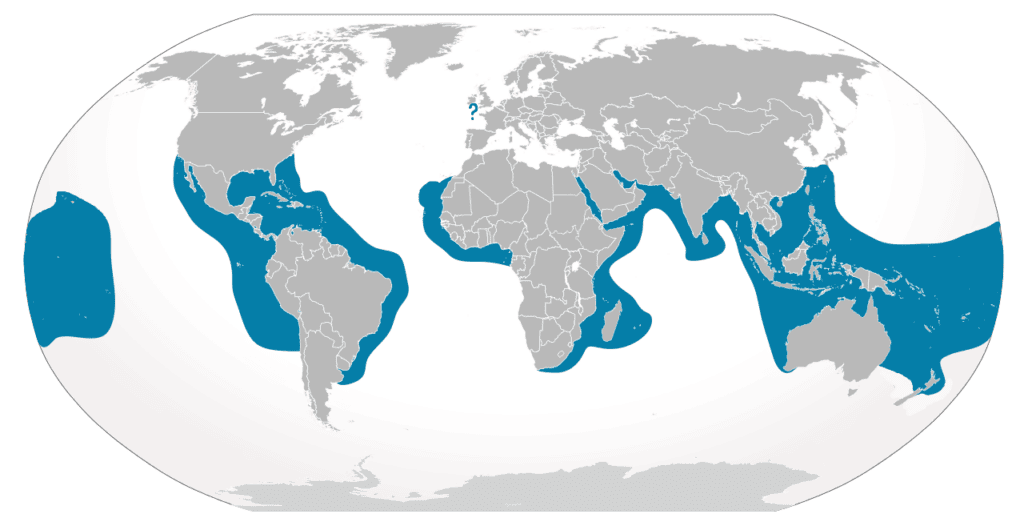
By Whitesachem – Own work / CC BY-SA 4.0 / Wikimedia commons
Tiger sharks have a widespread distribution in warm temperate, subtropical, and tropical waters around the world. However, they’re not found in the Mediterranean Sea. They may travel in the open ocean, but they’re more frequently found in coastal waters.
In the US, tiger sharks have been observed along the eastern and western coasts. Parts of their range around the world include:
- Coasts of Pacific Islands, such as the Hawaiian Islands
- Seas in Southeast Asia
- Along the coasts of Africa and Madagascar
- Arabian Sea
- Eastern and western coast of South America
- Gulf of Mexico and the Caribbean Sea
- Northern, eastern, and western coasts of Australia
The preferred habitat of tiger sharks is murky coastal waters, usually where runoff occurs. They mostly swim near the surface. Some tiger sharks have been reported swimming at depths up to 1,085 ft (331 m).
During the warmer months, tiger sharks are more common in temperate waters. Tiger sharks participate in seasonal migrations according to ocean temperatures. They return to tropical waters in the winter.
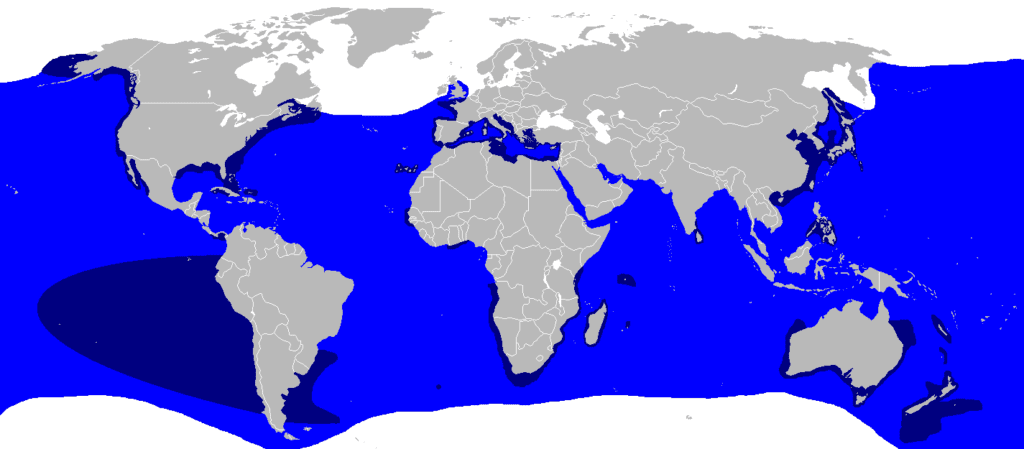
Me – Own work / CC BY-SA 3.0 / Wikimedia commons
The great white shark is less common in coastal areas compared to tiger sharks. As adults, great whites spend a lot of time in the open ocean. Juvenile great whites are more common in nearshore waters.
Great whites prefer waters that range between 50 and 80°F (10 and 27°C). They live in temperate and subtropical waters around the world.
Since great whites appear in nearshore and open ocean habitats, their geographic range is more widespread than that of tiger sharks. The geographic range of great whites includes, but is not limited to:
- Western Atlantic from Newfoundland Canada south to Argentina in South America
- Eastern Pacific from Alaska south to the coast of Chile
- Western Pacific from Siberia south to the region of Oceania
- Indian Ocean, including the Red Sea south to South Africa
- Eastern Atlantic from France to South Africa
- Mediterranean Sea
Great whites are warm-blooded, or endothermic. Tiger sharks are cold-blooded, or ectothermic. This means that great whites are capable of regulating their own body temperature.
Thanks to this ability, great whites are more likely to travel into colder waters because they can keep themselves warm.
Great whites may appear at the surface or travel at depths greater than 4,265 ft (1,300 m). They favor areas where their preferred food sources, such as sea lions and seals, are abundant.
Diet
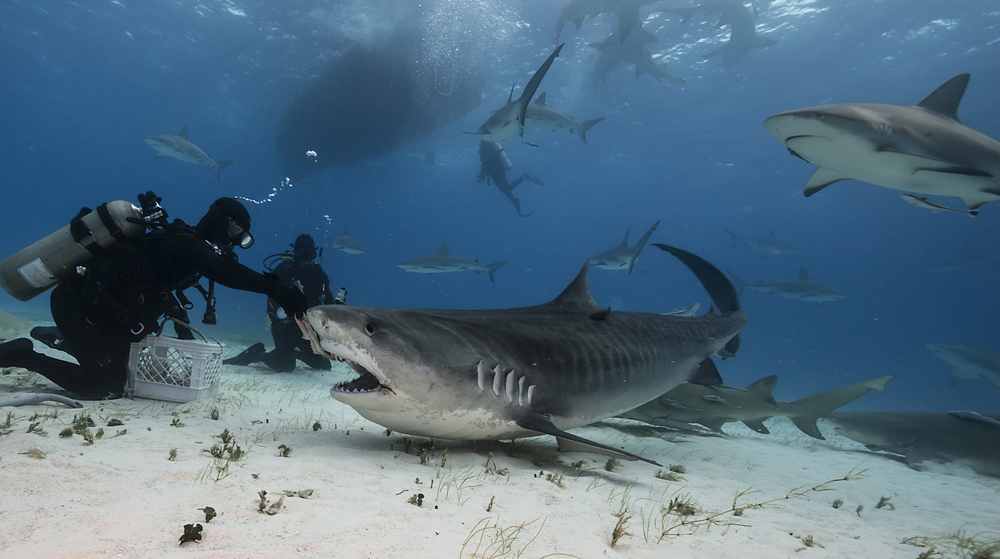
Tiger sharks are commonly referred to as garbage cans of the sea because of their varying diets. Tiger sharks aren’t picky eaters and will prey on pretty much anything they can find, including trash.
Tiger sharks have serrated teeth that allow them to tear at their prey with ease. They’re nocturnal, solitary hunters.
Tiger sharks will move into inshore waters at night to prey on a variety of bony fish and other marine animals, such as:
- Squid
- Sea turtles
- Rays
- Smaller sharks
- Sea birds
To hunt for prey, tiger sharks use ambushing tactics. Tiger sharks are slow-moving, but they’re capable of quick bursts of speed when pursuing prey. Rather than relying on speed or strength, tiger sharks use murky waters to camouflage themselves and wait to attack prey.

Great whites have a slightly different diet, mainly due to their range and preferred habitat.
Great whites won’t consume everything like tiger sharks. They mainly feed on seals and sea lions. Young great whites will feed on bottom fish, rays, schooling fish, and cephalopods.
Adult great whites may occasionally feed on rays, smaller sharks, tuna, dolphins, and dead whales. Great whites aren’t nocturnal and mostly feed during the day.
Great whites have powerful jaws capable of inflicting about 4,000 pounds (1,814 kg) of force on their prey.
Reproduction

Great whites and tiger sharks have different reproductive processes. Tiger sharks are ovoviviparous and give birth to live young without using the placenta to nourish the embryo.
Developing embryos are encased in large eggs inside female tiger sharks. The eggs provide the embryos with nourishment in the initial stages of their development. Once the embryo uses up its supply of nutrients, it uses uterine fluid for nourishment. This process is called embryotroph.
Female tiger sharks can give birth to 10–80 pups or more at one time.
Great white sharks are considered viviparous and oophagous.
Viviparity means that the young develop inside the female’s body. Oophagy refers to the eating of eggs by embryos still developing inside the female’s body. This means that great white embryos will eat the eggs of potential young for nourishment until they’re born.
Conservation Status

Tiger sharks are considered near threatened and great white sharks are vulnerable, according to the International Union for Conservation of Nature (IUCN).
Great whites receive more protection than tiger sharks. As apex predators, great whites are recognized for playing a key role in balancing out the food chain.
Great whites are also listed as an Appendix II species by the Convention on International Trade in Endangered Species (CITES). Appendix II species receive some international protection to prevent a more imminent threat of extinction.
Fisheries must immediately release any great whites they unintentionally catch. Tiger sharks are considered big game fish that are still legal to catch in many places.
Shark Attacks

The great white shark has had the most confirmed shark attacks in history compared to other shark species. The great white has historically been responsible for a total of 351 recorded attacks.
Out of these attacks, 292 were unprovoked and non-fatal, and the remaining 59 were unprovoked and fatal.
Tiger sharks have the second-highest number of confirmed shark attacks in history.
They’ve been historically responsible for 103 non-fatal, unprovoked attacks and 39 fatal, unprovoked attacks. This means that great whites have more than two times as many attacks recorded as tiger sharks or any other shark species.
Although these shark attack numbers may sound high, these are all the incidents reported throughout modern history. Sharks are not man-eaters like some movies make them out to be.

Humans are not on a shark’s menu. Attacks are often attributed to mistaking humans for prey items or provocation.
Great white sharks are considered dangerous because of their large size and powerful bite. Tiger sharks are curious and can easily become aggressive if provoked in any way.
The high number of attacks by tiger sharks is largely due to their range, which sits in close proximity to humans. An increase in recreational water activities along coasts has been correlated with an increase in shark attacks.
According to the International Shark Attack File (ISAF), there were 73 shark bites recorded in 2021. Nine of those attacks were fatal. Florida had the most shark attacks in 2021, with a total of 28 bites.
You may also like: Are Sharks Mammals: Where Do Sharks Fit in the Classification of Animals?
Similarities Between Tiger Sharks and Great White Sharks

Tiger sharks and great whites both have a widespread distribution. They can be found in most parts of the world in temperate, subtropical, and tropical waters.
Both species are large compared to most sharks. Many shark species are no more than 10 feet (3 meters) long.
Some other similarities between tiger sharks and great whites include:
- A part of the “Big Three” for highest number of attacks
- Both have a gray to dark gray dorsal surface color
- Long gestation period of about one year or more
- Serrated teeth for tearing prey apart
- Capable of short bursts of speed when hunting
Great whites and tiger sharks both appear at the ocean’s surface when hunting. However, great whites are known to travel much deeper.
These sharks also participate in seasonal migrations. However, migratory patterns differ due to their preferred habitats, range, and temperature regulation characteristics.
You may also like: Ancient Predators: How Long Do Sharks Live?
FAQ
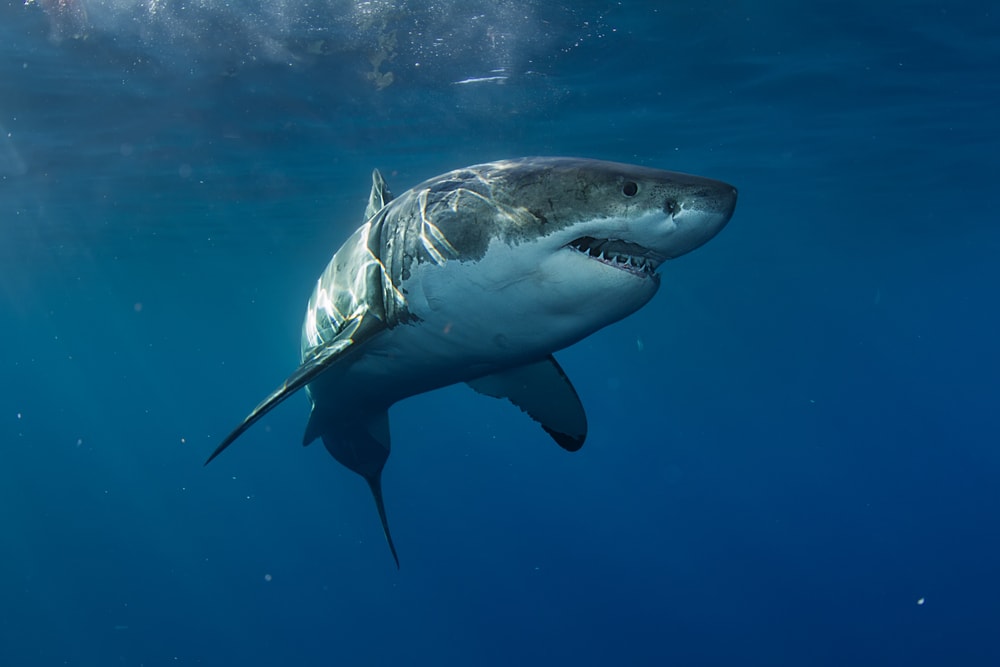
Can a great white shark eat a tiger shark?
Yes, great whites can eat tiger sharks. Due to their large size, great whites are capable of eating other large shark species. However, that doesn’t mean they do.
Great whites would rather eat their favored meal of sea lions and seals.
Do sharks have predators?
Yes, sharks have predators. The great white shark is an apex predator, which means it’s at the top of the food chain. It doesn’t have as many predators as other smaller shark species. The main predators of great whites and tiger sharks are humans and killer whales.
Juvenile sharks are more likely to have a wider variety of predators than adults because of their size.
What’s the biggest shark?
The biggest shark species in the world is the whale shark. It’s also the largest fish. Whale sharks can reach up to 66 feet (20 meters) in length and weigh around 40,000 pounds (18,144 kg)!
Their name comes from their feeding habits, which resemble those of whales. They open their mouths wide and swim through schools of small fish and plankton to feed. Whale sharks aren’t likely to be encountered in coastal waters because they’re a pelagic (open ocean) species.
How many types of sharks exist?
There are more than 500 shark species currently known and recognized. All of these species are split into different orders based on their characteristics. Carcharhiniformes is the largest order of sharks. Sharks are further divided into families and genus’.









